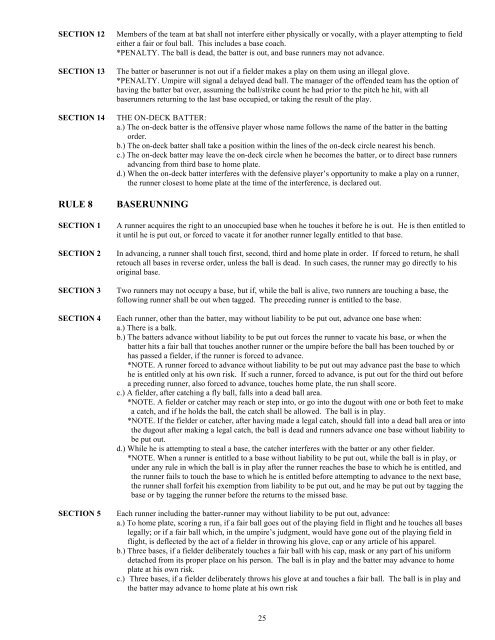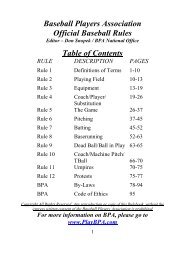baseball players association rule 1 definitions of terms
baseball players association rule 1 definitions of terms
baseball players association rule 1 definitions of terms
You also want an ePaper? Increase the reach of your titles
YUMPU automatically turns print PDFs into web optimized ePapers that Google loves.
SECTION 12<br />
SECTION 13<br />
SECTION 14<br />
RULE 8<br />
SECTION 1<br />
SECTION 2<br />
SECTION 3<br />
SECTION 4<br />
SECTION 5<br />
Members <strong>of</strong> the team at bat shall not interfere either physically or vocally, with a player attempting to field<br />
either a fair or foul ball. This includes a base coach.<br />
*PENALTY. The ball is dead, the batter is out, and base runners may not advance.<br />
The batter or baserunner is not out if a fielder makes a play on them using an illegal glove.<br />
*PENALTY. Umpire will signal a delayed dead ball. The manager <strong>of</strong> the <strong>of</strong>fended team has the option <strong>of</strong><br />
having the batter bat over, assuming the ball/strike count he had prior to the pitch he hit, with all<br />
baserunners returning to the last base occupied, or taking the result <strong>of</strong> the play.<br />
THE ON-DECK BATTER:<br />
a.) The on-deck batter is the <strong>of</strong>fensive player whose name follows the name <strong>of</strong> the batter in the batting<br />
order.<br />
b.) The on-deck batter shall take a position within the lines <strong>of</strong> the on-deck circle nearest his bench.<br />
c.) The on-deck batter may leave the on-deck circle when he becomes the batter, or to direct base runners<br />
advancing from third base to home plate.<br />
d.) When the on-deck batter interferes with the defensive player’s opportunity to make a play on a runner,<br />
the runner closest to home plate at the time <strong>of</strong> the interference, is declared out.<br />
BASERUNNING<br />
A runner acquires the right to an unoccupied base when he touches it before he is out. He is then entitled to<br />
it until he is put out, or forced to vacate it for another runner legally entitled to that base.<br />
In advancing, a runner shall touch first, second, third and home plate in order. If forced to return, he shall<br />
retouch all bases in reverse order, unless the ball is dead. In such cases, the runner may go directly to his<br />
original base.<br />
Two runners may not occupy a base, but if, while the ball is alive, two runners are touching a base, the<br />
following runner shall be out when tagged. The preceding runner is entitled to the base.<br />
Each runner, other than the batter, may without liability to be put out, advance one base when:<br />
a.) There is a balk.<br />
b.) The batters advance without liability to be put out forces the runner to vacate his base, or when the<br />
batter hits a fair ball that touches another runner or the umpire before the ball has been touched by or<br />
has passed a fielder, if the runner is forced to advance.<br />
*NOTE. A runner forced to advance without liability to be put out may advance past the base to which<br />
he is entitled only at his own risk. If such a runner, forced to advance, is put out for the third out before<br />
a preceding runner, also forced to advance, touches home plate, the run shall score.<br />
c.) A fielder, after catching a fly ball, falls into a dead ball area.<br />
*NOTE. A fielder or catcher may reach or step into, or go into the dugout with one or both feet to make<br />
a catch, and if he holds the ball, the catch shall be allowed. The ball is in play.<br />
*NOTE. If the fielder or catcher, after having made a legal catch, should fall into a dead ball area or into<br />
the dugout after making a legal catch, the ball is dead and runners advance one base without liability to<br />
be put out.<br />
d.) While he is attempting to steal a base, the catcher interferes with the batter or any other fielder.<br />
*NOTE. When a runner is entitled to a base without liability to be put out, while the ball is in play, or<br />
under any <strong>rule</strong> in which the ball is in play after the runner reaches the base to which he is entitled, and<br />
the runner fails to touch the base to which he is entitled before attempting to advance to the next base,<br />
the runner shall forfeit his exemption from liability to be put out, and he may be put out by tagging the<br />
base or by tagging the runner before the returns to the missed base.<br />
Each runner including the batter-runner may without liability to be put out, advance:<br />
a.) To home plate, scoring a run, if a fair ball goes out <strong>of</strong> the playing field in flight and he touches all bases<br />
legally; or if a fair ball which, in the umpire’s judgment, would have gone out <strong>of</strong> the playing field in<br />
flight, is deflected by the act <strong>of</strong> a fielder in throwing his glove, cap or any article <strong>of</strong> his apparel.<br />
b.) Three bases, if a fielder deliberately touches a fair ball with his cap, mask or any part <strong>of</strong> his uniform<br />
detached from its proper place on his person. The ball is in play and the batter may advance to home<br />
plate at his own risk.<br />
c.) Three bases, if a fielder deliberately throws his glove at and touches a fair ball. The ball is in play and<br />
the batter may advance to home plate at his own risk<br />
25



